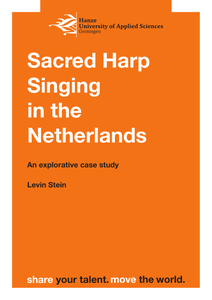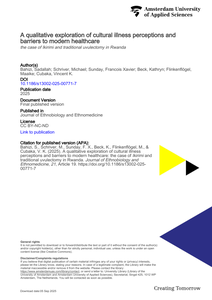The use of algorithmic tools by journalists for information-gathering has received particular attention in recent years. While it might facilitate the research process, there are also concerns about their impact on journalism. Based on reconstruction interviews with 27 journalists, we first answer the primary question to what extent journalists actually use algorithmic-driven tools for research purposes. Then, we analyze which folk theories journalists create during their use of algorithm-driven tools. Results show that algorithmic tools specifically designed for the journalistic research process are rarely or not at all used. Yet, more crucially,search engines and social media, that are driven by algorithms,play a major role when it comes to the search, selection, and verification of sources and information. However, journalists are notaware of this hidden research assistant facilitating their research process. When explicitly asked, they profess specific notions regarding the use of algorithmic-driven tools in the form of folk theories, which are predominantly negative regarding the influence of AI on journalism. At the same time, there is a still a strong feeling of a professional authority among journalists who feel they are able to work autonomously of any kind of influence,including algorithms.
DOCUMENT
Dasha Ilina’s video work Advice Well Taken: Folk Tales of Digital Savation uses the ‘techlore’ concept to find out what ‘urban legends’ are in the age of smartphones. You can watch the ‘director’s cut’ of the video installation here. You can also have a look at a selection of the catalogue here. The 2023 Impakt Festival information about the installation can be found here. The essay was commissioned by Dasha Iina for the catalogue that came out in November 2023 during the Impakt Festival in Utrecht, where the video installation premiered. Read the ‘cookie conversation’ with the artist here, conducted by the Impakt Festival.
MULTIFILE

This study employed an exploratory approach by applying practice theory to insights gathered throughthe triangulation of interview, document analysis and observation methodologies to 1) map the SacredHarp Singing practice scope and give a nuanced picture of its performativity in the Netherlands, witha particular focus on the Sacred Harp group from Amsterdam comparing it to one from Bremen and 2)investigate the underlying rise of transformative emotions, the social, secular, and religious meanings, andthe sense of belonging to an international community. The findings suggest that Sacred Harp enthusiastsin the region are keen on retaining the legacies of the traditional singers by establishing similar singingatmospheres and by following the practice’s historical customs and practices, including the communalsinging in the “hollow square” and the affinity towards democratic participation. The findings alsoindicate that while there is a noticeable level of commitment and excitement among local enthusiasts,the growth of the groups’ memberships is hampered by a lack of interest by the general public, possiblyin connection with insufficient strategies for publicizing the practice. Therefore, the existence of thesebarriers could imply that the practice would probably grow at a relatively slow pace in the region.
DOCUMENT

“Ik ben benieuwd hoelang het zal duren voor men ook kan schrijven: er is een tijd geweest dat men voor een pedofiel contact de gevangenis in ging. Iemand om die reden in voorarrest houden en een gevangenisstraf opleggen berust naar mijn overtuiging op een afschuwelijke vergissing, die rechtstreeks voortvloeit uit een taboe. Niet de rechter, maar de wetgever en dus wij allen blijven daar debet aan. Graag voeg ik mij bij mevrouw Mr. H. Singer-Dekker, waar zij schrijft dat ook zedendelinquenten vermoedelijk steeds meer gezien worden als mensen aan wie schuld ontbrak en die alleen behandeling behoeven.” 2 Wie het hier te bespreken onderzoek Gevangene van het verleden leest, weet dat de bovenstaande voorspelling (of is het hoop?) uit een publicatie uit 1970 maar zeer ten dele is uitgekomen. Behandeling en begeleiding in een justitieel kader zijn zeker gangbare reacties op gedrag van zedendelinquenten. Maar dat zedendelinquenten in onze tijd worden gezien als mensen aan wie geen schuld is toe te rekenen of die niet in de gevangenis terecht behoren te komen en slechts behandeling behoeven, is zeker niet gangbaar geworden. Integendeel, in het hier beschreven rapport wordt, in navolging van de Engelse criminoloog Stanley Cohen, in verband met zedendelinquenten geschreven in termen als ‘folk devils’ en ‘moral panic’. Deze begrippen zijn met name aan de orde als een ex-zedendelinquent vanuit de gevangenis of de TBS terugkeert in de samenleving. Het gaat daarbij niet om stigmatiserende begrippen maar om een analyse van de huidige situatie. Volgens Cohen, stellen de onderzoekers, worden politici, beleidsmakers, bestuurders, burgers, enzovoort soms door paniek bevangen wanneer zij worden geconfronteerd met regelovertredingen van personen, zoals voetbalvandalen, drugsgebruikers, pedofielen of straatrovers, die zij als een ernstige bedreiging zien voor de samenleving (p. 28).
LINK
Knowledge Building (KB) as a concept of social and societal knowledge production is meant to get away from the ‘mind-as-container’-based folk theory that posits learning as knowledge acquisition testedby reproduction quizzes (Bereiter, 2002). However, such a transitionmeans thinking differently to the mainstream educational process, and is not without its frictions associated with the change process.
LINK
This article uses a study of the life-story narratives of former classmates of Dutch and Moluccan descent to argue that the constructionist approach to intersectionality, with its account of identity as a narrative construction rather than a practice of naming, offers better tools for answering questions concerning intersectional identity formation than a more systemic intersectional approach. The case study also highlights the importance of the quest for origins in narratives. It demonstrates that theories of intersectionality are not justified in subsuming the issue of belonging under the identity marker of ethnicity, when all identities are performatively produced in and through narrative enactments that include the precarious achievement of belonging. The case study demonstrates that if narrative accounts of a (singular or collective) life fail to achieve narrative closure regarding roots, attempts to trace routes are seriously hampered.
DOCUMENT

The paper presents a framework that through structured analysis of accident reports explores the differences between practice and academic literature as well amongst organizations regarding their views on human error. The framework is based on the hypothesis that the wording of accident reports reflects the safety thinking and models that have been applied during the investigation, and includes 10 aspects identified in the state-of-the-art literature. The framework was applied to 52 air accident reports published by the Dutch Safety Board (DSB) and 45 ones issued by the Australian Transport Safety Bureau (ATSB) from 1999 to 2014. Frequency analysis and statistical tests showed that the presence of the aspects in the accident reports varied from 32.6% to 81.7%, and revealed differences between the ATSB and the DSB approaches to human error. However, in overall safety thinking have not changed over time, thus, suggesting that academic propositions might have not yet affected practice dramatically.
DOCUMENT

In this paper the first phase of a descriptive research project on musical preferences and music listening habits of first year’s conservatoire students is presented. The paper presents the background of the research project, the construction of a survey and the first results of this survey, which indicate that musical preferences and music listening habits of first year’s conservatoire students are highly varied. Possible refinements for the survey are discussed.The paper ends with first notions on how to not only use the findings for descriptive ends but also put them in the broader perspective of more general research on musical preferences.
DOCUMENT

Leren is niet alleen een psychologisch proces, maar ook een tijd- en plaatsgebondenproces. Om zicht te krijgen op dit proces zijn kwalitatieve onderzoeksmethodes nodig, betoogt Evert Bisschop Boele. In dit artikel laat hij zien wat het narratief biografisch interview als onderzoeksinstrument ons vertelt over het leren musiceren. Zijn conclusie is dat de scheidslijnen tussen formeel en informeel leren minder hard zijn dan gedacht en dat het zinvoller is te denken in termen van een meervoudig continuüm.
DOCUMENT

BackgroundUnderstanding cultural perceptions of illness is crucial for effective healthcare delivery. This study examines the ethnomedical concept of ikirimi, a culturally recognized illness in Rwanda characterized by perceived uvula abnormalities, and its traditional management through uvulectomy. This study explores the cultural understanding of ikirimi, its perceived causes, symptoms, and treatments, as well as barriers to integrating modern healthcare.MethodsAn exploratory qualitative approach was employed, involving in-depth semi-structured interviews with eight participants: traditional healers, individuals who underwent traditional uvulectomy, and healthcare providers. A grounded theory approach which analyzes data in systematic manner to generate new theories was applied, with coding conducted in English after initial transcription and analysis in Ikinyarwanda to preserve Indigenous concepts.ResultsParticipants described ikirimi as an illness affecting the uvula (named as akamironko or akamirabugari or agashondabugari in Ikinyarwanda), characterized by swelling, elongation, and pus-like discoloration. Reported symptoms included fever, difficulty swallowing, coughing, and weakness, with children identified as the most affected group. Traditional healers diagnosed ikirimi through visual inspection of uvular morphology and movement and treated it by cutting the affected part of uvula and is known as guca Ikirimi ‘traditional uvulectomy’. Barriers to integrating modern healthcare included skepticism about biomedical care, judgmental attitudes from providers, and communication gaps. Despite the prevalence of ikirimi, its biomedical correlates remain unclear, though participants associated it with severe throat illnesses such as tonsillopharyngitis.ConclusionThe findings highlight ikirimi as a socially constructed illness with deep cultural roots, significant health implications, and persistent barriers to modern healthcare. Addressing these barriers requires culturally sensitive approaches that integrate Indigenous knowledge with biomedical practices. Future research should explore the biomedical correlates of ikirimi and foster collaboration between traditional and modern healthcare systems to improve patient outcomes.
DOCUMENT
